

Robertson-Aikman remembers it well: “I particularly recall this estimate because in the week of one of his visits, not so long before he died, we built 1,000 units and were averaging 750 units per week.”Īfter re-tooling the Series I, by then three years old, Robertson-Aikman replaced it with the Series II in 1962.

Crucially, he told Robertson-Aikman, “Perhaps an annual turnover of as many as 1,000 pieces might be possible.” “By the spring of 1959, a prototype was in use, and it was decided to show it to the then-Senior Technical Editor of Gramophone Magazine, Percy Wilson, a man of great enthusiasm and some useful ideas.” Asked what he thought of its commercial possibilities, Wilson replied that he and one or two of his friends would like to own one. I recall going into the small tool room and asking if we had any aluminium tube. At that time, the Scale Model Equipment Co Ltd, as SME was then titled, had a useful precision-engineering capability built up over the preceding 12 years. It came about because my burgeoning interest in hi-fi had reached the point where I was dissatisfied with what the market offered. He told me “the Series I precision pick-up arm was envisaged in the autumn of 1958. Robertson-Aikman, above all an engineer, was also a music lover able to construct his own system. Even the near-elliptical tonearm cut-out served as the default arm aperture for countless manufacturers that supplied armless decks, from Garrard to Thorens to Technics.įounded in 1946 by Robertson-Aikman, SME made scale models and parts for the model-engineering trade and hobbyist model builder. The SME 3009 was, and is, the most popular and influential quality tonearm in history. I trust TONE readers will immediately let me know if there’s a separate high-end tonearm that comes anywhere close to that figure.

Robertson-Aikman felt the more affordable M2 was its true successor.Īfter four decades, total sales neared a half-million units. The cost difference between an SME Series II Improved and a Series V kept the former in production for its value as an entry-level product. It stayed in production until 2003-04, but not because the superior Series V supplanted it both models ran concurrently for almost 20 years. That’s the reason why boxed, second-hand examples in mint condition can command $500 at UK audio flea markets. Due to his unfailing honesty and integrity, SME founder Alastair Robertson-Aikman found it mildly disconcerting that the headshell-mounting system became known colloquially as the SME mount Ortofon deserved the credit.Īs a result of the arm’s ability to accept the heavy, low-compliance MCs we so love today, its performance is not that of a 50-year-old arm but of a still-viable contender. Moreover, the first headshells used with the 3009-prior to the arrival of the familiar, drilled-out SME design-were Ortofon shells with SME badges on the front. Indeed, many audiophiles still swear by it, and with good reason: Despite it being associated, in the minds of many, with high-compliance moving-magnet cartridges because of strong associations with Shure, it was, in fact, designed with the then-dominant, heavy, low-compliance Ortofon moving-coil cartridges in the SPU series. Ignoring both xenophobia on the part of the British and envy on the part of everyone else, it remains the most successful high-end tonearm of all time, and is the template for superior “universal” tonearms able to handle a wide range of cartridges on an equally wide range of “motor units.” Depending on when you start the counting, last year marked the 50th anniversary of the SME 3009 tonearm.


 0 kommentar(er)
0 kommentar(er)
